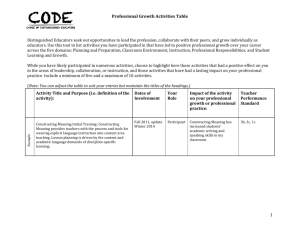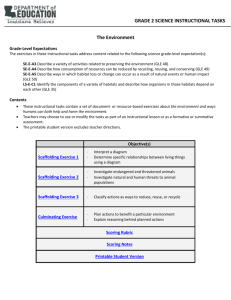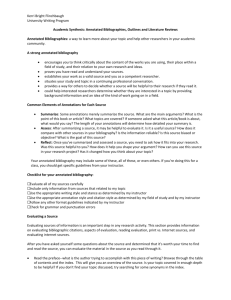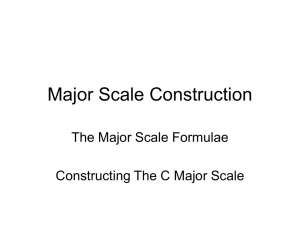CONSOLIDATING ONE NOVEL STRUCTURE WHILST CONSTRUCTING TWO MORE
advertisement
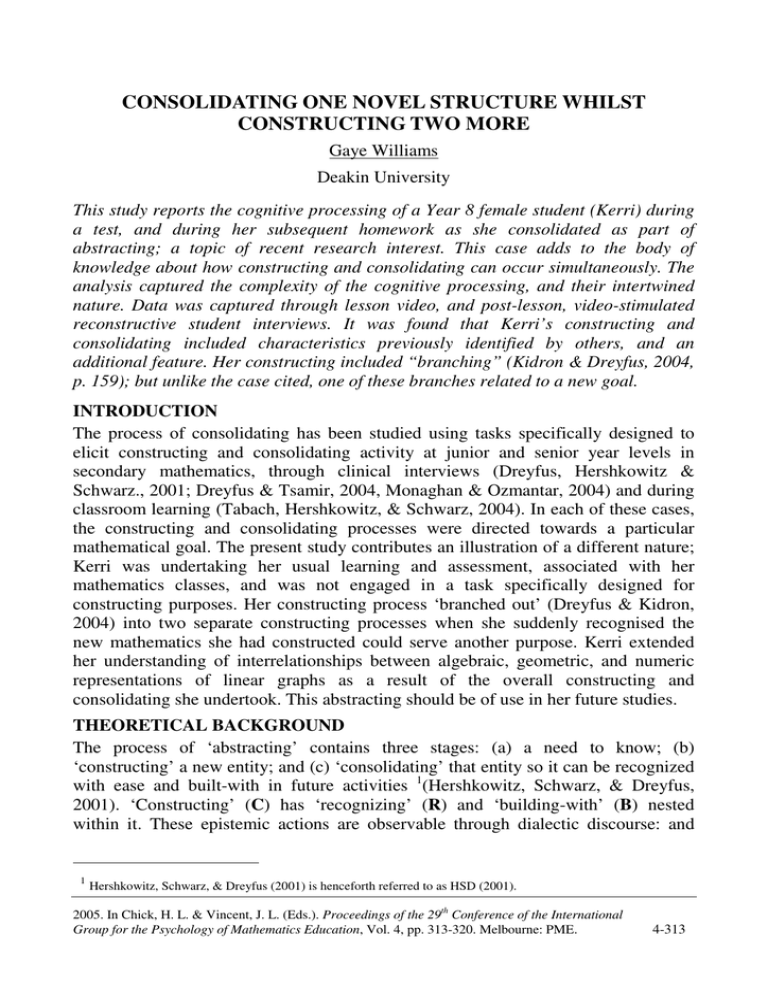
CONSOLIDATING ONE NOVEL STRUCTURE WHILST CONSTRUCTING TWO MORE Gaye Williams Deakin University This study reports the cognitive processing of a Year 8 female student (Kerri) during a test, and during her subsequent homework as she consolidated as part of abstracting; a topic of recent research interest. This case adds to the body of knowledge about how constructing and consolidating can occur simultaneously. The analysis captured the complexity of the cognitive processing, and their intertwined nature. Data was captured through lesson video, and post-lesson, video-stimulated reconstructive student interviews. It was found that Kerri’s constructing and consolidating included characteristics previously identified by others, and an additional feature. Her constructing included “branching” (Kidron & Dreyfus, 2004, p. 159); but unlike the case cited, one of these branches related to a new goal. INTRODUCTION The process of consolidating has been studied using tasks specifically designed to elicit constructing and consolidating activity at junior and senior year levels in secondary mathematics, through clinical interviews (Dreyfus, Hershkowitz & Schwarz., 2001; Dreyfus & Tsamir, 2004, Monaghan & Ozmantar, 2004) and during classroom learning (Tabach, Hershkowitz, & Schwarz, 2004). In each of these cases, the constructing and consolidating processes were directed towards a particular mathematical goal. The present study contributes an illustration of a different nature; Kerri was undertaking her usual learning and assessment, associated with her mathematics classes, and was not engaged in a task specifically designed for constructing purposes. Her constructing process ‘branched out’ (Dreyfus & Kidron, 2004) into two separate constructing processes when she suddenly recognised the new mathematics she had constructed could serve another purpose. Kerri extended her understanding of interrelationships between algebraic, geometric, and numeric representations of linear graphs as a result of the overall constructing and consolidating she undertook. This abstracting should be of use in her future studies. THEORETICAL BACKGROUND The process of ‘abstracting’ contains three stages: (a) a need to know; (b) ‘constructing’ a new entity; and (c) ‘consolidating’ that entity so it can be recognized with ease and built-with in future activities 1(Hershkowitz, Schwarz, & Dreyfus, 2001). ‘Constructing’ (C) has ‘recognizing’ (R) and ‘building-with’ (B) nested within it. These epistemic actions are observable through dialectic discourse: and 1 Hershkowitz, Schwarz, & Dreyfus (2001) is henceforth referred to as HSD (2001). 2005. In Chick, H. L. & Vincent, J. L. (Eds.). Proceedings of the 29th Conference of the International Group for the Psychology of Mathematics Education, Vol. 4, pp. 313-320. Melbourne: PME. 4-313 Williams together form the RBC-model (HSD, 2001). Williams (2002) integrated Krutetskii’s (1976) mental activities (‘comprehending’, ‘analyzing’, ‘synthetic-analyzing’, ‘synthesizing’, and ‘evaluating’), and an additional activity she empirically identified (‘evaluative-analysis’), into the RBC-model (see Figure 1). The types of thinking represented in Figure 1 are now described, and are later elaborated through the illustration in this paper. Recognizing involves seeing the relevance of previously known procedures, processes, and strategies (a process requiring an understanding of the mathematics involved, or comprehending, and which can also involve an analysis of structure). Building-with (B) involves using known mathematical ideas, concepts, and strategies in an unfamiliar combination, or an unfamiliar sequence to solve a problem. B can include finding patterns (analysis), simultaneously considering more than one aspect of a problem (synthetic-analysis), and using this synthetic-analysis for purposes of judgement (evaluative-analysis). Constructing involves integrating mathematical concepts to form a new mathematical structure (synthesis), and can include immediate recognizing of the relevance of a newly abstracted entity for a new purpose (evaluation). The shaded parts of Figure 1 are used to distinguish spontaneous constructing from constructing guided by an expert other. For more information about differences in these ways of constructing, see Tabach, Hershkowitz, and Schwarz (2004) and Williams (2004) respectively. Process of autonomous, spontaneous constructing CONSTRUCTING (Synthesizing, Evaluating) Novel Creating by a research mathematician BUILDING-WITH Applying, Analyzing, Syntheticanalyzing, Evaluative-analyzing) RECOGNIZING (Analyzing, Comprehending) Figure 1. Williams’ (2002) integration of observable cognitive elements (HSD, 2001) with Krutetskii’s (1976) mental activities illustrating their nested nature. Consolidating possesses three characteristics (B, Building-with; RfB Reflecting upon building-with, and Rf, reflecting generally) (Dreyfus & Tsamir, 2004) although Monaghan & Ozmantar (2004) question whether Rf always occurs. Consolidating a novel structure whilst constructing another has been identified in several contexts including Year 7 students working in a pair (Tabach, Hershkowitz, et al., 2004) and a learner of tertiary mathematics thinking alone (Dreyfus & Kidron, 2004). Ivy, abstracting in tertiary mathematics (Kidron & Dreyfus, 2004), constructed and consolidated through a “branching” constructing process which later reunited as she 4-314 PME29 — 2005 Williams pursued her ultimate goal. Her branching process involved simultaneously considering two directions, continuing along one, and later linking the two branching constructing processes in pursuit of her overall goal. In the present study, constructing is examined through the cognitive activity represented in Figure 1, and examination of consolidating is informed by the research above. The research question: By what process did Kerri construct and consolidate new knowledge, and how does her activity further illuminate these processes? RESEARCH DESIGN This study was part of a broader study of autonomous, spontaneous, and creative student activity during mathematics learning in Year 8 classrooms in Australia and the USA. Data was generated as part of the international Learners’ Perspective Study. Each class was video-taped for ten or more lessons using three cameras that focused respectively on the class, the teacher, and different focus students each lesson. A mixed-image video was produced in class with the focus students at centre screen, and the teacher as an insert in the corner. In addition to providing evidence of social influences on cognitive processing, this video provided salient stimuli for individual, post-lesson reconstructive student interviews undertaken to generate valid data (Ericcson & Simons, 1980) associated with student classroom activity including student thinking. The student operated the video remote to find the parts in the lesson that were important to her, and then discussed what was happening, her thinking, and her feelings. Kerri’s interview focused on the mathematical activity of interest to the US research team (mathematical entity developed, and social influences on that development), rather than specifically on the student’s cognitive processing (interview focus in Australia for other cases in the author’s broader study). Due to Kerri’s ability to articulate her thoughts, and her desire to do so, the interview captured rich data about Kerri’s cognitive processing as well. THE CONTEXT Just prior to the start of the research period, the class were taught to find equations of linear graphs by plotting two points, ruling the line between them, drawing a rightangled triangle to measure ‘rise’ and ‘run’ (called a ‘slope triangle’ by the teacher), taking the ratio of these lengths to find the gradient, finding the y-intercept by inspection, and substituting the gradient and y-intercept into the equation y = mx + b. Kerri’s interview reconstruction of the test on this procedure just prior to the research period showed she forgot to bring graph paper so created a novel solution process. After the test, and prior to research period, students undertook a homework exercise to find the equation to a line given the co-ordinates of two points, and to find the length of the line segment between the points. The length of line segment formula had not been taught; the teacher expected students to plot graphs, measure lengths, and find the y-intercepts by inspection. In class the next day (Lesson 1 of the research period) the teacher demonstrated ‘finding the equation of a line without graphing’ (when two points were given). Evidence for this case is presented below as a PME29 — 2005 4-315 Williams narrative. Data sources are indicated by ‘[SI]’ for Kerri’s interview after Lesson 1, and ‘[L1]’ for video of Lesson 1. ANALYSIS AND RESULTS It was inferred that Kerri’s constructing activity prior to Lesson 1 was spontaneous (self-instigated and self-directed, see Williams, 2004) because the teacher awarded 200% to Kerri’s test thus suggesting the originality of the work. During her interview, Kerri reconstructed her thinking in her test. Her novel method entailed sketching and recognizing that a slope triangle lay between the two points given “cuz you can picture a line in a little right triangle on it” [SI]. She then used her knowledge of the Cartesian Axis System to find the lengths of the horizontal and vertical sides in this triangle by subtraction, and then recognized she could substitute x and y as well as the constant m into the general linear equation y = mx + b to find another constant (this complex substitution method had not been previously taught). if you find the slope and the … difference of the points and … then we can substitute, oh perfect. So I just wrote the equation. [SI] Kerri demonstrated her pleasure in this discovery of how substituting could be applied by adding “oh perfect” to illustrate her affective state when she found the way to proceed. When reflecting on this process in her interview, she commented on the quality of the newly developed process “Actually I thought like- I thought it was kind of a big idea… it wasn’t too big for me” [SI]. The next evening, whilst doing her homework (using the teacher’s graphical method), Kerri developed a generalized understanding of the new method she had developed in the specific numerical question in the test. (Notation for transcript: Three dots indicate omissions that do not alter the meaning. Square brackets: researcher additions clarifying the context): I was doing my graph [during homework], and then I like realized like- really solidly, … I got the same answer, … [by measuring as] if you do the subtraction. [SI] Kerri thought about both methods as she did her homework, and realized each gave the same answer. I firstly provide evidence about what Kerri realized, then later describe Kerri’s further novel thinking during that homework session. What Kerri knew ‘really solidly’ was evident in class the next day [L1]. In class, Kerri drew attention to the teacher’s sketch, used as she demonstrated ‘finding the equation of a line without a graph’: “You still graphed it” [L1-Kerri]. Kerri demonstrated she could find the gradient by operating on elements of the ordered pairs representing the points on the line without referring to the slope triangle: “I would just be like the difference in Y is two, and the difference in X is one. So that's your slope” [SI]. In Lesson 1, in preference to using a plot or a sketch, Kerri used her fast method of subtracting relevant elements of ordered pairs to find the side lengths to take the ratio to find the gradient. She continued using her new method even though most students relied on graphical representations to support their thinking, and also queried Kerri’s method. The additional constructing Kerri undertook during her homework session, after she had found the relationships between operations on elements of ordered pairs, and the rise and the run is now described. 4-316 PME29 — 2005 Williams and then also [during my homework] … we had to find the distance between the two plots, and it was supposed to graph them too-… I was using Pythagoras’ Theorem. [SI] 13. Insight ç: With the distance between two points on a Cartesian plane, Pythagoras’ theorem can be thought of using co-ordinates, without drawing the slope triangle (y2 – y1)2 + (x2 – x1)2 side lengths 12. Insight ß: Two points on a line provide information about its gradient: the ratio of the difference in y values to the difference in x values Gradient = (y2 – y1) / (x2 – x1) C C B 11. Other cognitive artifacts recognized B Novel B Novel R 7. Find lengths by measuring 8. Own method: Subtract y-lengths to find rise 9. Compare lengths from both methods for purpose of judgment Newly formed cognitive artifacts now available for Recognizing because consolidating had commenced 10: Insight å. The difference in x values and difference in y values (respectively) are equivalent to the length of the horizontal and vertical sides of a slope triangle for that line. So side lengths can be found by operating on relevant attributes of ordered pairs. C Novel B B 5. More recognizing: Repeat process developed with x values and horizontal lines to find run. 1. The is a line with a ‘little right-triangle’ between the two points given 6. Pythagoras’ Theorem with lengths of sides in right-angled triangles R Cognitive artifacts initially available for Recognizing 2. Gradient is the ratio of the amount of rise to the amount of run in the slope triangle 3. Cartesian Axis System provides information about lengths of vertical and horizontal lines 4. Teacher’s method of finding lengths of lines by drawing graphs and measuring. Figure 2 Kerri’s Constructing and Consolidating Activity PME29 — 2005 4-317 Williams Once Kerri realized how to find the vertical and horizontal side lengths in the slope triangle, she recognized it was useful for another purpose—finding the length of the line segment. In her interview after Lesson 1, Kerri described what she understood (and used in class) that the students at her table did not [SI]: Interviewer So what do you think that you discovered, that other people didn't? Kerri [the question] said graph and find the distance- and most people would graph the line, and then do the little thing [slope triangle]. But I would find what- see that'd be two and then one [subtracting y values and x values], so you do um, a squared plus b squared equals c squared. … if you make it a right triangle- it's the hypotenuse- not just the distance In doing so she demonstrated an ability to shift flexibly between representations and use both specific numerical values and general formulae as she justified her method. Figure 2 (above) diagrammatically represents Kerri’s spontaneous cognitive activity described below, and aids communication of this activity. Figure 2 superimposes Kerri’s cognitive activity on the diagrammatic representation used in Figure 1. In this way, the cognitive elements Kerri displayed are evident through both the diagram and the text. Each element of cognitive activity in Figure 2 is represented by a number to add clarity to the text. The Figure 1 convention of shading all spontaneous activity has not been followed with arrows that would obscure Figure 2 (these arrows were left unshaded). Figure 2 includes three copies of Figure 1; the original Constructing of Insight å (Figure 2; 10) at the bottom of the page, and the additional constructing of both Insights ß and ç (Figure 2; 12, 13), that use the outcome of Insight å as a cognitive artefact. This further constructing is represented by the two smaller copies of Figure 1 positioned side by side at the top of Figure 2. They both share the same ‘Recognizing ellipse’ containing Insight å, but draw also from the original ‘Recognizing ellipse’ (base of diagram, cognitive artefacts possessed prior to Kerri’s initial constructing). Both Figures 1 and 2 inform the interpretation below. Kerri analyzed her sketch and recognized cognitive artefacts (right-angled triangle in sketch [1], co-ordinates associated with a Cartesian Axis System [3]), and built-with these cognitive artefacts (subtracted y values, and x values in the two ordered pairs [8, 5]) to develop a novel way to solve the problem. When Kerri undertook practice exercises for homework, she simultaneously considered her new method [8] and the teacher’s method [7] (synthetic-analysis, as part of building-with). She compared the lengths obtained by each method and found they were the same [9] (evaluativeanalysis, part of novel building-with). As a result of this process she constructed new insight [10]—she realised she no longer needed the triangle to find the lengths. In constructing new insight, Kerri synthesized (sub-category of constructing) by subsuming the attributes of the Cartesian Axis (that enabled her to find the lengths of the vertical and horizontal lines) into relevant attributes of the ordered pairs representing points on the line [9]. She operated upon these ordered pairs without needing a sketch to aid her thinking. She then found the gradient through additional operations on these ordered pairs [12]. Kerri then recognized a new purpose for 4-318 PME29 — 2005 Williams Insight å (evaluating as part of spontaneous constructing). Kerri synthesized Pythagoras’ Theorem [6], with her novel mathematical structure [10], to construct Insight ç—the length of a line segment can be found by operating on elements of the ordered pairs at the end of the segment [13]. In developing Insights ß and ç [12, 13], Kerri Built-with Insight å [10]; thus consolidating it during novel building-with. DISCUSSION AND CONCLUSIONS Figure 2 draws attention to the increased complexity in thinking that occurred during Kerri’s sustained exploratory activity associated with three insights. The whole of Figure 2 captures Kerri’s overarching constructing of interconnections between different aspects of, and representations of function. Kerri’s cognitive activity illustrated the progressive connecting of different representations that occurred through synthetic-analysis and evaluative-analysis. Further research is required to explore whether, and how, these cognitive processes could be elicited during classroom learning, and whether doing so would increase constructing opportunities. Kerri demonstrated the three stages of abstracting (HSD, 2001): (a) she needed to know a way to answer the test question; (b) constructed as a result of this need; and (c) consolidated her new learning as she recognized a way to satisfy another need. She also exhibited the three identified stages of consolidating (Dreyfus & Tsamir, 2004); novel building-with; through her test solution (B), reflecting on novel B when she compared it with the teacher’s process during homework (RfB), and reflecting generally about associated positive affect, what she thought about other students’ querying her approach, and the quality of the construction achieved (Rf). Kerri was consolidating her novel B as she constructed her first insight thus illustrating the intertwined nature of consolidating and constructing processes. In addition, Kerri demonstrated that consolidating was occurring through the characteristics she displayed that have previously been identified by Dreyfus and Tsamir (2004): “impetus”, “self-evidence”, “confidence”, “flexibility”, and “awareness”. Kerri displayed these characteristics as she: (a) recognized her novel structure for other activity; (b) justified her thinking; (c) changed from tentative knowing to knowing “really solidly”; (d) flexibly moved between representations; and (e) knew other students required visual support that she did not, and that she had found a “big idea”. Kerri, like Ben, in Dreyfus and Tsamir (2004), was a gifted student, so although these findings support the presence of the identified consolidating characteristics during the activity of gifted students (R, RfB, Rf), they do not address the absence of Rf found by Monaghan & Ozmantar, (2004) in another case. As Kerri was in a class of gifted students, and the other students did not spontaneously construct in this instance, the study does point to features of the situation that provided impetus for Kerri’s novel thinking. In this case, the absence of a ‘tool’ gave impetus to novel thinking. This is contrary to findings in other contexts where tools were found to enhance learning (e.g., Tabach, Hershkowitz, et al., 2004). There was also opportunity to sustain novel thinking during reflection undertaken with ‘hands on activity’ that preceded ‘telling rules’. Aspects of the idiosyncratic learning situation in which Kerri’s thinking PME29 — 2005 4-319 Williams occurred could inform research into factors that promote learning in which complex mathematical thinking and high positive affect can co-exist during the generation of new knowledge. Although some aspects of Kerri’s constructing process were not explored (e.g., whether she explored unproductive pathways), Kerri’s reconstruction of her thinking was sufficiently rich to demonstrate ‘branching for another purpose’ as a possible outcome of consolidating during further constructing. Acknowledgements: Thanks to Mary Barnes for her useful comments that contributed to the final version of this paper. This data forms part of the US data set for the international Learners’ Perspective Study directed by David Clarke at the University of Melbourne http://www.edfac.unimelb.edu.au/DSME/lps/. Data was analyzed using the facilities and technical assistance available through the International Centre for Classroom research. References Dreyfus, T., Hershkowitz, R., & Schwarz, B. (2001). Abstraction in context: The case of peer interaction. Cognitive Science Quarterly, 1(3), 307-368. Dreyfus, T. & Kidron, I. (2005). Interacting parallel constructions: a solitary learner and the bifurcation diagram. Technical report, Tel Aviv University, Israel. Dreyfus, T., & Tsamir, P. (2004). Ben's consolidation of knowledge structures about infinite sets. Journal of Mathematical Behavior, 23(3), 271-300. Ericsson, K., & Simons, H. (1980). Verbal reports of data. Psychological Review, 87(3), 215-251. Hershkowitz, R., Schwarz, B., & Dreyfus, T., (2001). Abstraction in Context: Epistemic Actions. Journal for Research in Mathematics Education, 32(2), 195-222. Kidron, I., & Dreyfus, T. (2004). Constructing knowledge about the bifurcation diagram: Epistemic actions and parallel constructions. In M. J. Høines & A. B. Fuglestad (Eds.), Proc. 28th Conf. of the Int. Group for the Psychology of Mathematics Education (Vol. 3, pp. 153-160). Bergen, Norway: PME. Krutetskii, V. (1976). Psychology of Mathematical Abilities in Schoolchildren. J. Kilpatrick & I. Wiszup [Eds.], J. Teller (Translator), Chicago: The University of Chicago Press. Monaghan, J., & Ozmantar, M. (2004). Abstraction and consolidation. In M. J. Høines & A. B. Fuglestad (Eds.), Proc. 28th Conf. of the Int. Group for the Psychology of Mathematics Education (Vol. 3, pp. 353-360). Bergen, Norway: PME. Tabach, M., Hershkowitz, R., &Schwarz, B. (under review). The construction and consolidation of mathematical knowledge within dyadic processes: A case study, Educational Studies in Mathematics. Williams, G. (2002). Identifying tasks that promote creative thinking in mathematics: a tool. In B. Barton, K. Irwin, M. Pfannkuch & M. Thomas (Eds.), Mathematics Education in the South Pacific (Vol. 2, pp. 698-705). Auckland New Zealand., Mathematical Education Research Group of Australasia Conference. Williams, G. (2004). The nature of spontaneity in high quality learning situations. In M. J. Høines & A. B. Fuglestad (Eds.), Proc. 28th Conf. of the Int. Group for the Psychology of Mathematics Education (Vol. 4, pp. 433-440). Bergen, Norway: PME. 4-320 PME29 — 2005

